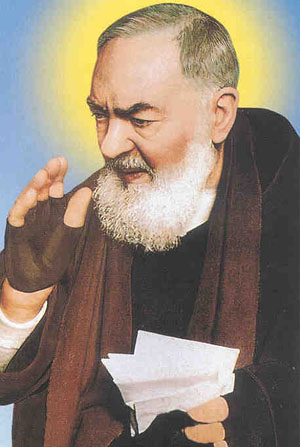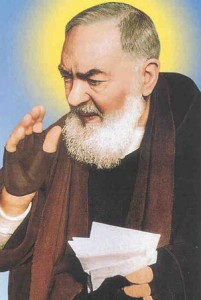Padre Pio
A few years ago I was holidaying in Sicily, taking in the sights around Mount Etna and the town of Taormina.
There are many wonderful memories that can accompany such a trip. Sicily is the kind of place which overwhelms the senses and leaves deep impressions.
On this occassion however, the trip became memorable for one rather bizarre and haunting reason.
Padre Pio.
For the uninitiated, Padre Pio is something of a phenomenon within the Catholic church, and is largely famed for his stigmata, his ability to levitate and his powers of bi-location.
Being in possession of such supernatural powers, a whole host of miracles were naturally attributed to the good Padre and a large following of devotees around the world soon attached themselves to this apparent saint within their midst.
Although many sceptics within the Catholic Church doubted the veracity of the Padre’s powers, his huge popularity among the faithful ensured that, upon his death in 1968, the case for his beatification gathered a momentum that was impossible to ignore.
By 2002 Pope John Paul The Second had no choice but to bow to the inevitable and declare the Padre a Saint.
Although I was brought up in a very Catholic household, this devotion to saints and fervent belief in miracles is something which has always eluded me.
There is a superstition about it all which I find hard to fathom and, try as I might, I find I cannot suspend my devotion to reality long enough to become a believer.
I am a faithless heathen, in other words.
That year in Sicily however, offered me a brief insight into the manner in which some things come to permeate our consciousness.
Everywhere we looked that summer, the beaming, kindly face of Padre Pio seemed to be staring back at us.
In souvenir shops an impressive range of Pio adorned paraphernalia was available. T-shirts, tea cups, key rings, even bits of rock from Mount Etna, no object was too banal or too outlandish that it could not be embellished with the smiling Padre’s image.
In cafes and restaurants, the familiar gaze would invariably beam down upon us from the walls.
Out on the roads the face of the good Padre would stare back at us on the bumper stickers of the cars up ahead.
Even in public toilets, there he would be, hanging above the wash basin, gently reminding the patrons that “cleanliness is next to godliness”.
Padre Pio, was everywhere.
Not a day could pass without encountering him, without pondering the mysteries of his existence. So much so that it became a sort of a game to see who could spot the Padre first.
On one occassion we managed to find a restaurant that was conspicuously Pio free. No walls were adorned with his image, no plates or cups or spoons were graced with his gaze. We sat in disbelief for a while then sighed with relief. Finally some respite from the omnipresent holy man!
As I sat there relaxing, I stared down at the little vase of plastic flowers on the table. Tiny little white blooms with a happy yellow centre. And there, amid the petals and the colour. There he was. The grinning, contened face of Padre Pio.
I remember actually letting out a squeak. A mix of terror and delight that caused all heads to turn in my direction.
Curious as to my outburst my companions asked what was up, but, dumbstruck all I could do was point to the flowers and whisper “The Padre”.
There really was no escape.
And so it was that “The Padre” seeped into our consciousness. The daily encounters led us to wonder who he was exactly and why he was so revered. We came to know of his mysterious, holy qualities and of his miracle working. Suddenly Padre Pio came to mean something more than a smiling priest. He was a mystery, a cult, a hero.
He had meaning. A meaning we could see in the faces of the people around us. People who clearly took their devotion to Padre Pio very seriously.
In the midst of all this worship and adoration, amidst the constant bombardment from his image it was hard not to begin to feel some measure of connection with the man.
In much the same manner that a modern day celebrity can enter our lives (whether we want them to or not), Padre Pio became a familiar, comforting figure to us that summer. A figure so prolific in his manifestations that in the end we stopped being aware of him.
At some point he was simply there. Simply a given.
While none of us actually succumbed to the Padre to the extent that we could believe in him, our experience of the devotion of his followers, the passion with which he was unquestionably revered, nevertheless allowed us to understand how such a figure could take on an importance in people’s lives.
We could feel it around us, this genuine devotion and love. And at its source was Padre Pio.
If we had stayed in Sicily much longer, who knows how long it would have taken before we started to believe ouselves.
For it is such a powerful combination of influences, this mixture of emotion and iconic imagery, this unquestionable devotion, this shared experience, that at some point the subliminal influence becomes irresistible, belief inevitable.
Towards the end of that summer however, we came home, and our exposure to Padre Pio ceased. Over time he became nothing more than a faded memory, a vaguely remembered figure. The smiling padre who had followed us around Sicily that year and made us giggle.
Last week however, he made a rather dramatic return, when his exhumed corpse was put on show in the Padre Pio Shrine of San Giovanni Rotondo in Southern Italy.
When I first saw him there, staring out at me on my TV screen I found it difficult to decide what it was I felt.
Besides an initial ghoulish curiosity as to the state of preservation of a 40 year old corpse, I couldn’t help but wonder what the point of it was, what this exhumation and public display could mean.
Seeing him lying there like that, his face shrouded in a wax mask, his body clothed in heavy Capuchin robes , I couldn’t help but think that, far from being the ultimate act of faith and devotion, this exhumation was actually some sort of failure in belief.
It was as if his mere image wasn’t enough any more. Didn’t satisfy the demands of his followers.
Not content with his image, with the reports of his miracle working, they needed the real thing, this corpse, in order to sustain their devotion.
It wasn’t enough to hold Padre Pio inside themselves as an idea, a miracle, a belief. As something spiritual.
They needed something more earthly, more tangible, more real.
They needed the Padre himself. They needed his corpse.
Exhumation and public display of saints is nothing new in the Catholic Church, of course, and some would argue that it is the very preservation of the Padre which offers proof as to his holiness, which offers proof to sceptics like myself, that mystical events do take place in this world. That saints exist, that God exists.
Just look at this untainted body, they proclaim, and then deny that such metaphysical forces are not at work.
I could of course reply that the unmasking and de-robing of the Padre could strengthen their argument in this regard, but that would rather be beside the point.
Because the point is that faith, true faith, should surely not require that our saints are exhumed and displayed. Faith in itself should be enough.
Faith in itself, implies that proof is never needed. All that is required is belief.
That summer, before his beatifcation, before his exhumation, the power of that belief was to be felt in the streets of Taormina.
It was a faith and belief that permeated the atmosphere and was capable of touching even cynical, atheistic souls such as myself.
Seeing that supine corpse last week diminished some of that mystery for me.
The spiritual, inexplicable, mysterious were nothing more than I had always suspected them to be.
A charade. A plastic mask.



The best part of the tale is that I bought a terrible and very tacky souvenir of the Padre (a blue glitter homage made from a pice of volcanic rock) which I gave to my parents.
The idea was they would be horrified by the ghastliness of the thing.
To my horror, however, they LOVED it and were very pleased to have received a little Pio figurine.
Like I say, they are pretty Catholic and I wonder sometimes how I can possibly have become such an atheist.
That damn thing now confronts me every time I go home, smiling down at me from the mantlepiece and ironically mocking me…..so it goes
Thanks God you saw the light.
The “saint” has been, a.o, a fervent fascist.
More a padrino than a padre, actually.
Take care and be happy.